
Thursday, December 30, 2010
Wednesday, December 15, 2010
The world's largest employers
 The world over, economies are beginning to look up: some quite rapidly while others at a rather sluggish pace. And employment generation too has begun at a healthy rate almost everywhere, barring a few hard-hit economies in Europe. While companies in India are on a hiring spree, as in many other Asian nations, it is interesting to note who the world's biggest employers are. Colossal organisations, both in the private as also the public sector, provide employment to millions of people across the world. So here is a list of list some giant enterprises which are the world's largest employers.
The world over, economies are beginning to look up: some quite rapidly while others at a rather sluggish pace. And employment generation too has begun at a healthy rate almost everywhere, barring a few hard-hit economies in Europe. While companies in India are on a hiring spree, as in many other Asian nations, it is interesting to note who the world's biggest employers are. Colossal organisations, both in the private as also the public sector, provide employment to millions of people across the world. So here is a list of list some giant enterprises which are the world's largest employers. 1. Wal-Mart Stores, US: 2,100,000
 Wal-Mart Stores, Inc runs a chain of department stores across the globe. Founded by Sam Walton in Rogers, Arkansas in 1962, Wal-mart is the largest grocery retailer in the United States. It also owns and operates the North American company, Sam's Club. Wal-Mart operates in Mexico as Walmex, in the United Kingdom as Asda, and in Japan as Seiyu. It has wholly owned operations in Argentina, Brazil, Canada, and Puerto Rico. Wal-Mart's operations can be fragmented into three divisions: Wal-Mart Stores US, Sam's Club, and Wal-Mart International. The company does business in nine different retail formats: super centers, food and drugs, general merchandise stores, bodegas (small markets), cash and carry stores, membership warehouse clubs, apparel stores, soft discount stores and restaurants. Wal-Mart's operations have often come under the scanner for its huge foreign product sourcing, low employee health insurance enrollment, resistance to union representation, alleged sexism, etc.
Wal-Mart Stores, Inc runs a chain of department stores across the globe. Founded by Sam Walton in Rogers, Arkansas in 1962, Wal-mart is the largest grocery retailer in the United States. It also owns and operates the North American company, Sam's Club. Wal-Mart operates in Mexico as Walmex, in the United Kingdom as Asda, and in Japan as Seiyu. It has wholly owned operations in Argentina, Brazil, Canada, and Puerto Rico. Wal-Mart's operations can be fragmented into three divisions: Wal-Mart Stores US, Sam's Club, and Wal-Mart International. The company does business in nine different retail formats: super centers, food and drugs, general merchandise stores, bodegas (small markets), cash and carry stores, membership warehouse clubs, apparel stores, soft discount stores and restaurants. Wal-Mart's operations have often come under the scanner for its huge foreign product sourcing, low employee health insurance enrollment, resistance to union representation, alleged sexism, etc.
2. Indian Railways: 1,632,659
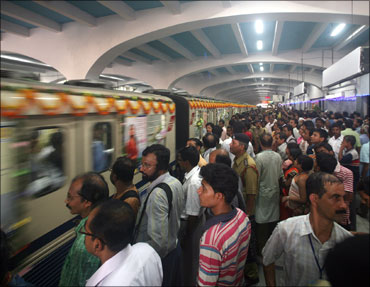 Indian Railways is the single largest employer in India and the fourth largest the world over, with 1.42 million employees. The state-owned Raliways are also on the verge of hiring more people soon.
Indian Railways is the single largest employer in India and the fourth largest the world over, with 1.42 million employees. The state-owned Raliways are also on the verge of hiring more people soon.Recently, Railway Minister Mamata Banerjee said that Indian Railways, one of the world's largest and busiest networks, will be filling up close to 170,000 vacant posts. Once that happens, Railways could well become the world's second largest employer. Indian Railways transports close to 20 million passengers everyday.
 The China National Petroleum Corporation is a state-owned fuel-producing corporation and the largest integrated oil and gas company in the People's Republic of China.
The China National Petroleum Corporation is a state-owned fuel-producing corporation and the largest integrated oil and gas company in the People's Republic of China.CNPC, China's flagship energy enterprise, plays an important role in China's oil and gas production and supply. The company produces 2.75 million barrels of crude oil and 5.6 billion cubic feet of gas per day.
It has 3.06 billion metric tons of oil reserves and 2,320.1 billion cubic metres of gas reserve. CNPC's oil and gas production account respectively for 57.7 per cent and 78.3 per cent of China's total output.
In 2005, there were explosions at a CNPC owned petrochemical plant causing six deaths, a mass evacuation, and a massive oil spill over the Songhua River.
4. National Health Service, Britain: 1,626,000
 In Britain, one in every 23 persons from the working population, is employed by the National Health Service. Over 1.626 million people work for the NHS, making England a nation of health workers, if not that of shopkeepers. The number of NHS employees has constantly risen since the last 14 years, with as many as 59,000 people joining NHS in 2009 alone. The NHS employs 386,400 nurses, 109,000 doctors and 122,100 scientists and other therapists.
In Britain, one in every 23 persons from the working population, is employed by the National Health Service. Over 1.626 million people work for the NHS, making England a nation of health workers, if not that of shopkeepers. The number of NHS employees has constantly risen since the last 14 years, with as many as 59,000 people joining NHS in 2009 alone. The NHS employs 386,400 nurses, 109,000 doctors and 122,100 scientists and other therapists. State Grid Corporation of China was founded on December 29, 2002 as a pilot state-owned corporation by the State Council. SGCC's core business is to build and operate power grids and provide power supply.
State Grid Corporation of China was founded on December 29, 2002 as a pilot state-owned corporation by the State Council. SGCC's core business is to build and operate power grids and provide power supply.The company has registered capital of RMB 200 billion yuan and service area covering 26 provinces. By the end of 2005, SGCC accumulated a total asset of RMB 1176.7 billion Yuan with a debt-asset ratio of 61.96 per cent, and possessed 195,899 km of 220KV and above transmission lines with a transforming capacity up to 616.64 GVA. SGCC serves 128 million customers.
6. Sinopec: 639,690
 Sinopec, or the China Petroleum and Chemical Corporation, is one of the major petroleum companies in China. Sinopec's business includes oil and gas exploration, refining, and marketing; production and sales of petrochemicals, chemical fibers, chemical fertilisers, and other chemical products; storage and pipeline transportation of crude oil and natural gas; import, export and import/export agency business of crude oil, natural gas, refined oil products, petrochemicals, and other chemicals.
Sinopec, or the China Petroleum and Chemical Corporation, is one of the major petroleum companies in China. Sinopec's business includes oil and gas exploration, refining, and marketing; production and sales of petrochemicals, chemical fibers, chemical fertilisers, and other chemical products; storage and pipeline transportation of crude oil and natural gas; import, export and import/export agency business of crude oil, natural gas, refined oil products, petrochemicals, and other chemicals.
7. Deutsche Post, Germany: 502,545 employees
 Deutsche Post -- also called Deutsche Post DHL -- is the world's largest logistics group, says Wikipedia.
Deutsche Post -- also called Deutsche Post DHL -- is the world's largest logistics group, says Wikipedia.Headquartered in Bonn, Germany, it employs 502,545 employees worldwide.
It boasts of revenues in excess of $100 billion. After the German mail body, Deutsche Bundespost, Deutsche Post was born. Over 30 per cent of its shares are held by Germany's KfW bank, and it is listed on DAX stock market.
8. Siemens Group, Germany: 461,000 employees
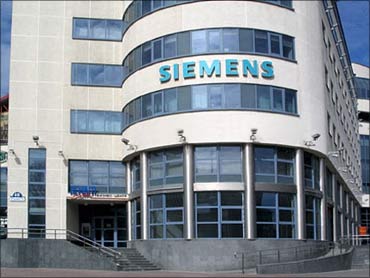 Europe's largest engineering fiant, Siemens, is a major multinational company. It employs over 461,000 people. It headquarters are located in Berlin, Munich and Erlangen.
Europe's largest engineering fiant, Siemens, is a major multinational company. It employs over 461,000 people. It headquarters are located in Berlin, Munich and Erlangen. Siemens is engaged in three major business sectors: industry, energy, and healthcare. Siemens is listed on the Frankfurt and New York stock exchanges.
 McDonald's Corporation, the world's largest chain of fast food restaurants, is also a major employment generator. Globally the burger chain employs close to 447,000 people.
McDonald's Corporation, the world's largest chain of fast food restaurants, is also a major employment generator. Globally the burger chain employs close to 447,000 people.McDonald's jobs are not very high paying and thus jobs that do not pay very well are at times referred to as McJobs. McDonald's restaurants typically offer burgers, chicken products, french fries, breakfast items, soft drinks, shakes, and desserts.
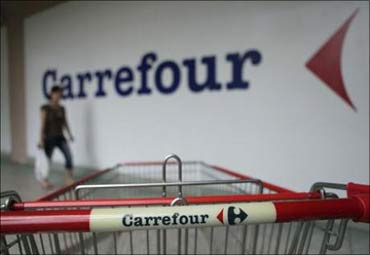 Carrefour is a French hypermarket chain with outlets worldwide. Carrefour means 'crossroads' in French. It is the largest hypermarket chain in terms of size, and the second largest retail group in revenue and third largest in profit after Wal-Mart and Tesco. Carrefour operates mainly in Europe, China, Colombia, Brazil, Argentina and in the Dominican Republic, but also has shops in North Africa and other parts of Asia.
Carrefour is a French hypermarket chain with outlets worldwide. Carrefour means 'crossroads' in French. It is the largest hypermarket chain in terms of size, and the second largest retail group in revenue and third largest in profit after Wal-Mart and Tesco. Carrefour operates mainly in Europe, China, Colombia, Brazil, Argentina and in the Dominican Republic, but also has shops in North Africa and other parts of Asia.
The first Carrefour store opened in June 1957, in suburban Annecy. The group was created by Marcel Fournier, Denis Defforey and Jacques Defforey and grew into a chain from this first sales outlet. In 1999 it merged with Promodes, known as Continent, one of its major competitors in the French market.
11. Compass Group, UK: 410,074
 Britain's Compass Group is a contract foodservice and support services multinational company. It is the world's largest contract foodservice company and has operations in over 50 countries, according to Wikipedia. Listed on the London Stock Exchange, the group employs over 410,000 people.
Britain's Compass Group is a contract foodservice and support services multinational company. It is the world's largest contract foodservice company and has operations in over 50 countries, according to Wikipedia. Listed on the London Stock Exchange, the group employs over 410,000 people. 12. United Parcel Service, US: 407,000
 The United States Postal Service is an independent agency of the US responsible for providing postal service in the country.
The United States Postal Service is an independent agency of the US responsible for providing postal service in the country.
In the US, it is often referred to as the Post Office, Postal Service, or US Mail.
The USPS operates the largest civilian vehicle fleet in the world, with an estimated 260,000 vehicles.
The company's employees deliver mail at an average yearly cost of $235 per residence as of 2009.
Fierce competition from Internet, e-mail and private outfits like United Parcel Service and FedEx has forced USPS to adjust its business strategy and to modernise itself of late.
13. Foxconn, China: Over 400,000
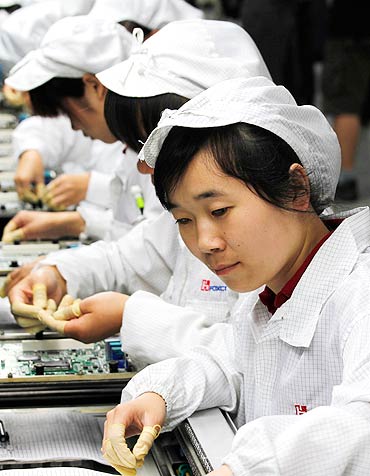 Foxconn is the world's biggest contract electronics maker. Terry Gou is the chairman of the $46-billion Taiwanese technology giant that employs over 400,000 workers.
Foxconn is the world's biggest contract electronics maker. Terry Gou is the chairman of the $46-billion Taiwanese technology giant that employs over 400,000 workers.Foxconn is part of Taiwan's Hon Hai Precision Industry Company.
Foxconn manufactures iPhones, iPads and spare parts for Apple Inc, desktop computers and parts for Hewlett-Packard and Dell, mobile phones for Motorola and other electronic goods for many other top brands, including Sony, Nokia and Microsoft.
Foxconn factories resemble mini-cities but its work ethics, managerial practices besides poor salaries were stated to be reasons for recurring suicides, which the company was unable to stem.
Newspaper reports have for long stated that Foxconn is a very secretive company which uses a dictatorial methods and military-style discipline to bullying its army of workers.
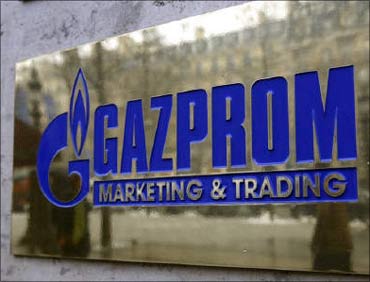 Gas giant Gazprom is the largest enterprise in Russia.In 1989, when the erstwhile USSR's ministry of gas industry was corporatised, Gazprom was born.
Gas giant Gazprom is the largest enterprise in Russia.In 1989, when the erstwhile USSR's ministry of gas industry was corporatised, Gazprom was born.Gazprom generates close to 20 per cent of the world's natural gas. It has gas and oil fields across the world. Gazprom has over 396,500 employees.
15. DaimlerChrysler, Germany: 382,724 employees
 The world's 13th largest car manufacturer, Daimler (earlier called DaimlerChrysler) employs over 382,700 people.
The world's 13th largest car manufacturer, Daimler (earlier called DaimlerChrysler) employs over 382,700 people.The company is known for its high precision and super-performance cars, trucks and buses. The company also has big interests in aerospace.
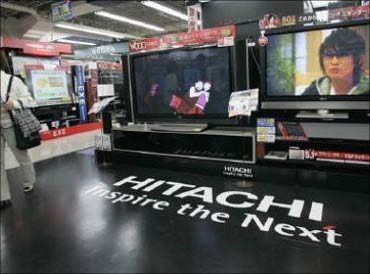 Japanese technology and services multinational Hitachi has its headquarters in Tokyo.
Japanese technology and services multinational Hitachi has its headquarters in Tokyo.It is the world's third largest technological major in terms of revenue. The tech giant employs more than 355,800 people.
17. China Telecom Corp. Ltd: 285,105
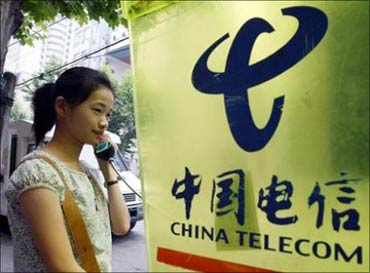 China Telecom Corp. Ltd. is the largest fixed line service and mobile telecommunication provider in the People's Republic of China.
China Telecom Corp. Ltd. is the largest fixed line service and mobile telecommunication provider in the People's Republic of China.As of April 2008, the company provided services to 216 million subscribers. The company was formerly a state-owned monopoly, but now divided into largely autonomous provincial branches.
China Telecom has been listed on the Hong Kong and New York stock exchanges since 2002, but the Chinese government still retains majority ownership.
 Some studies also take into account national armies as employers and going by that parameter China stands ahead of everyone else. The PLA would thus be the world's largest employer in the world. China, an economic superpower, is also a military powerhouse. People's Liberation Army, the Chinese army, employs over 2.255 million active personnel.
Some studies also take into account national armies as employers and going by that parameter China stands ahead of everyone else. The PLA would thus be the world's largest employer in the world. China, an economic superpower, is also a military powerhouse. People's Liberation Army, the Chinese army, employs over 2.255 million active personnel. 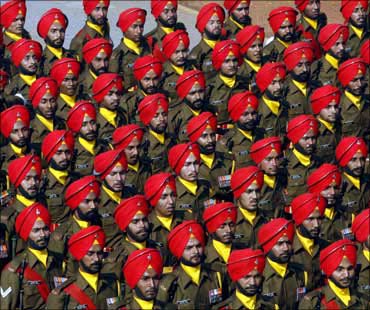 The Indian Army employs over 1,325,000 active personnel.
The Indian Army employs over 1,325,000 active personnel.The Indian Army is the world's second largest army after China. If taken along with business enterprises, the Indian Army would be the world's seventh largest employer.
This is just the land forces component of the Indian Armed Forces and does not take into account the Indian Air Force and the Navy.

The Korean People's Army, also known as the Inmin Gun, employs over 1,106,000 active personnel, making it the world's third largest army.
21. Russian Army: 1,027,000

The Armed Forces of the Russian Federation employs about 1,027,000 troops.
22. US Army: 549,015
 The United States Army is the branch of US armed forces that engages in land-based military operations. It employs over 549,000 soldiers.
The United States Army is the branch of US armed forces that engages in land-based military operations. It employs over 549,000 soldiers. Ref: http://www.rediff.com/business/slide-show/slide-show-1-the-worlds-biggest-employers/20101207.htm
Tuesday, December 7, 2010
South America's best-kept secret - Uruguay
 Expats are increasingly attracted to the charms of Montevideo
Expats are increasingly attracted to the charms of Montevideo After a decades-long pause, expatriates from rich countries are again arriving in Uruguay.
In 2009, for the first time in 44 years, the country saw a positive migration influx, while the number of applicants who got residence permits has tripled in only four years.
Immigration to Uruguay
- 3,825 residence permits were awarded in 2009, compared with 1,216 in 2005
- 50% of new legal residents come from Argentina and Brazil
- 288 Americans obtained their residence in 2009
- Europeans make 15% of new residents, with Germans and Spaniards leading the pack
Source: Uruguayan Office of Migration
Although most of the new legal residents come from neighbouring countries (half from Argentina and Brazil), the number of American and European applicants is also growing.
And even though the figures remain small, the arrival of hundreds of people from the northern hemisphere is starting to be noticed in this country of 3.3 million.
"If you look south of the US, Uruguay stands out for its clean water, good and healthy food, a good educational system, and good infrastructure, both in terms of roads and of internet access," Ronald Yoder, an American who just settled in the country, told the BBC.
Mr Yoder came to Uruguay in 2009, after Casey Research, an American investing newsletter he reads, rated the country as a good place to live in and invest.
This 64-year-old entrepreneur and investor decided to move to Piriapolis, a seaside resort situated an hour's drive from the capital, Montevideo.
"Start Quote
End Quote Paul Elberse Dutch expatIf more people knew that life here was so pleasant, they would come in hordes. I hope the secret doesn't leak or everyone will come "
For Paco Bermejo, a 44-year-old Spanish entrepreneur who came to Montevideo with his family last March to start a garden centre and landscaping business "in Uruguay, you feel optimistic about the future, something you don't find in Europe anymore".
"You get a better quality of life, more safety, easy-going people and good weather," he adds.
Michael Brown was transferred to Uruguay from California in 2005, and when it was time to go back, he decided to stay.
"You get good food, good wine, nice people, plus there is no rush-hour traffic, and I can get by speaking almost no Spanish at all," he told the BBC.
On the mapThis new trend is a result of a combination of elements, said Carlos Flanagans, director of consular affairs at the ministry of foreign affairs.
"Uruguay is a politically stable country, it is one of the few Latin American countries that was not affected by the economic crisis, and investors see it as an attractive option. Plus, in 2008, a pioneering migration law was passed that gives immigrants the same rights and opportunities that nationals have," he explains.
Juan Fischer, a local immigration and relocation lawyer, believes the economic crisis and tax increases in the US have made more Americans look overseas, "and that has translated into more people coming here".
 Expats say they get a better quality of life in the Uruguayan capital
Expats say they get a better quality of life in the Uruguayan capital On the phone from Las Vegas, where he was a speaker at the International Living Conference, Dr Fischer told the BBC that this organisation, which promotes relocation abroad, has put Uruguay on the map.
"Since 2005, Uruguay has been increasingly promoted as a place to live and retire. They all look for better quality of living at a lower cost.
"Uruguay looks attractive to them because it is a safe place. Also, they can better blend in compared to other Latin American countries, because our population is of European descent and we have got a large middle class," he adds.
The vast majority of Uruguay's population is of European descent, hundreds of thousands having arrived between the 1880s and the 1950s.
Then, economic downturns and a military government (between 1973 and 1985) turned Uruguay into a country of emigrants.
Now, it is quite easy for new immigrants to get a Uruguayan residence permit, Dr Fischer says.
"They are not required to invest or to buy property here. They just need to prove a monthly income of $650 (£413), which is not much for most foreigners; they need a certificate of good conduct and a birth certificate too."
Paul Elberse, a Dutch financial professional who came to Uruguay with his wife and children in 2002 for work reasons and decided to stay, says he does not understand why so few people come to live here.
"If more people knew that life here was so pleasant, they would come in hordes. I hope the secret doesn't leak or everyone will come," he half-jokes.
But Mr Yoder believes the word about Uruguay has already got out.
"When you find something good you tell other people about it. A lot of us are telling friends to come and visit. It [has become] a trend, and it is definitely a growing one," he said.
Friday, December 3, 2010
Dhoni Signed 26 Crore Endorsement Deal
The endorsement deal is for 3 year, with the country's largest spirit maker. Dhoni will do endorsement of Mcdowell Soda & also the whole UB Group.
With this Deal MS Dhoni came equal with Bollywood superstar Shah Rukh Khan in the endorsement.
 Mahendra Singh Dhoni was rated the world's highest paid cricketerby Forbes magazine He had earned $10 million last year.
Mahendra Singh Dhoni was rated the world's highest paid cricketerby Forbes magazine He had earned $10 million last year. Ref: http://indiascanner.com/ms-dhoni-signed-26-crore-endorsement-deal-28377
Thursday, November 11, 2010
YOUNGEST CEO IN THE WORLD
Suhas Gopinath, the HERO
When 14-year-old Suhas Gopinath started Global Inc ten years ago from a cyber cafe in Bengaluru, he didn't know that he had become the youngest CEO in the world.
Today, Global is a multi-million dollar company with offices in the United States, India, Canada, Germany, Italy, the United Kingdom, Spain, Australia, Singapore and the Middle East and has 100 employees in India and 56 abroad.
Among the several honors that have been bestowed upon this young man, the most prestigious is the invitation to be a member of the Board of the ICT Advisory Council of the World Bank..
In 2007, the European Parliament and International Association for Human Values conferred 'Young Achiever Award' on him. He was also invited to address the European Parliament and other business dignitaries assembled in the EU Parliament. He is also recognised as one of the 'Young Global Leaders' for 2008-2009 by the prestigious World Economic Forum.
Suhas is the youngest member ever in the World Economic Forum's history. The other members include the Louisiana governor Bobby Jindal, Hollywood star Leonardo Di Caprio, musician A R Rahman, Prince of Brunei, etc.
In this interview from his office in Bengaluru, Suhas Gopinath talks about his decade long journey and his dreams for the future.
 Suhas Gopinath with former President APJ Abdul Kalam
Suhas Gopinath with former President APJ Abdul KalamOn his childhood:
I come from a middle class family. My father worked as a scientist for the Indian Army. I used to study in the Air Force school in Bengaluru.
As a child, I was more interested in animals and veterinary science. But when I saw my friends who had home computers talk about it, I had this urge to learn and talk in their wave length.
But we didn't have a computer at home. In those days, computers were very expensive and we couldn't afford one.
So, what I did was, I located an Internet cafe near my house. With my modest monthly pocket money of Rs. 15, I couldn't afford to surf the net every day.
I noticed that the shop was closed in the afternoon from 1 PM to 4 PM. So, I offered to open the shop for him after my school hours and take care of the customers.
In the bargain, he let me browse the net for free. That was the first business deal of my life and it turned out to be a successful one.
 Suhas with Microsoft co-founder Bill Gates
Suhas with Microsoft co-founder Bill GatesOn building websites using open source technology:
Once I got the chance to manage the shop and browse the net, I started building websites. It became my passion in no time.
I got hooked to open source technology after I started looking for e-books on how to build websites. They were not available as they were created in propriety sources.
So, I started using open source to build websites.
On getting the first contract to build a website
There is a freelance marketplace on the web where I could register and offer my services to build websites. I registered myself there as a website builder.
The first website I had to do was free of cost as I had no references. It was for a company in New York.
My first income was $100 when I was 13 for building another website but I didn't have a bank account. so, I told my father that I built a website and got paid for it.
I was not excited to get the money because money was not a factor that drew me to it. It was the passion for technology that attracted me. I used to build websites free of cost also. I was only a 9th standard student.
After that, I built my own portal and called it Coolhindustan.com. It was focused on NRIs. It was a portal where I wanted to showcase my skills.
After that, many companies approached me to be their web designer.
 Suhas Gopinath speaking to students' at a conference in Austria
Suhas Gopinath speaking to students' at a conference in AustriaOn buying his first computer
When I was in the 9th standard itself, I had made enough money to buy a computer for myself. At that time, my brother was studying engineering and my father thought he needed a computer.
In no time, I also bought one for myself. But we didn't have a net connection at home.
My spending hours in the net cafe working on websites did affect my studies. I spent the entire summer vacation after the 9th standard in the cafe.
On rejecting a job offer from the US
When I was 14, Network Solutions offered me a part-time job in the US and they said they would sponsor my education in the US. I rejected the offer because that was the time I had read a story about Bill Gates and how he started Microsoft.
I thought it was more fun to have your own company. Many US companies used to tell me that I didn't even have a moustache and they felt insecure taking my services. They used to connect my ability with my age and academic qualifications.
So, I wanted to start my own company and show the world that age and academic qualifications are immaterial. I decided then that when I started a company, I would recruit only youngsters and I would not ask for their academic qualifications and marks cards. I follow that in my company.
 Suhas delivering a lecture at the DLD Conference
Suhas delivering a lecture at the DLD ConferenceOn starting his own company at 14
Soon after my 9th standard summer vacation, I started my own company, Global Inc. I wanted the name Global or Global Solutions but both were not available, so I named it Global.
I registered my company in the US as in India; you will not be able to start a company unless you are 18. It takes only 15 minutes to start a company in the US.
I became the owner and CEO of the company. My friend, an American who was a university student, became a board member.
I was very excited because that was what I wanted to do. From that day, I started dreaming of making my company as big as Microsoft.
On doing badly in school
In my pre-board CBSE exam, I failed in Mathematics. The school headmistress was shocked because that was the first time I had failed in any subject. She called my mother and said she was horrified by my performance.
At home, like any typical South Indian mother, my mother made me swear on her head that I would focus on academics.
I told my mother that the world's richest man Bill Gates had not completed his education. Why do you force me then, I asked her. She then said, I am sure his horoscope and yours are not the same!
I come from a family where entrepreneurship is considered a sin. My mother was quite upset. She wanted me to do engineering, then an MBA and work in a good company.
As per my mother's wishes, I took a four-month sabbatical from my company and studied for my board exam. I passed with a first class.
I still feel that you cannot restrict yourself to bookish knowledge. I believe that practical knowledge is more important.
In the first year, the turnover of Global Inc was Rs 1 lakh (Rs 100,000). The second year, the turnover went up to Rs 5 lakh (Rs 500,000).
 Suhas receiving the Incredible Europe Innovation Award at Vienna
Suhas receiving the Incredible Europe Innovation Award at ViennaOn looking at Europe as a market
Till I was 16 or 17, I didn't tell my parents that I had started a company. I kept it a secret because I thought they would object to it. They only knew that I was a freelancer.
We used to build websites and also offer online shopping and e commerce solutions. We even gave part time work to a few programmers in the US when we got many projects but we never had any office.
When I was 16, I saw that there was enormous business opportunities in Europe as a majority of the Indian IT companies were working for American companies.
When I contacted a Spanish company, it rejected my offer saying Indians do not know Spanish. As an entrepreneur, you can't accept rejection, especially when you are young.
I hired five student interns from some Spanish universities and told them they would be paid based on their successful sales.
They were the people who met the companies and bagged the projects for us. By now, we decided to have a home office in Spain.
I replicated the same model in Italy. I contacted some Italian university students.
 Suhas meeting with Sheikha Nayhan, Minister for Higher Education, the UAE
Suhas meeting with Sheikha Nayhan, Minister for Higher Education, the UAEOn going to Germany to talk about entrepreneurship
The American newspapers were writing a lot about me as the world's youngest CEO at 14 from India, from a middle class background.
It was a good story for the BBC also. I never expected to be in the limelight. For me, starting a company was like realising a passion of mine.
On seeing these stories, a B-school in Germany invited me to talk to its students on entrepreneurship. I was 17 then. By now, I had completed my 12th standard and had joined Engineering in Bengaluru.
When I was 18, we set up an office -- the European HQ in Bonn. Then, we moved to Switzerland. Six months back, we started our operations in Vienna as well.
That is how we spread our operations from a small Internet cafe to become a multinational company with significant operations in Europe, Middle East, the US, Canada, the UK, Australia, etc.
On registering a company in India at the age of 18
The day I turned 18, I registered our company in India as Global, opened an office and recruited four people. I opened the office next to the Internet cafe where I started my career.
By then, he had closed shop and joined a factory as an employee. Whenever I met him, I used to tell him, 'you made me an entrepreneur but you stopped being one.'
On moving to creating products
We wanted our company also to be a product development company and our focus was on education, like the software that manages everything about a child while in school starting from admission till he/she leaves school and becomes an alumnus.
It is a nasty software which students are going to be quite unhappy about! This software was aimed only at the Indian market. I want to be the market leader in ICT in education.
Our software is being used in more than 100 schools all over India, Singapore and the Middle East.
We are now in the process of raising funds. Once we do it, we will separate the company into two -- service and product development. I want to concentrate on products as I can't sail on two boats.
 World Bank president Robert Zoellick
World Bank president Robert ZoellickOn meeting former President Abdul Kalam
I met Dr Abdul Kalam when he was the President of India. I was 17 or 18 then. My meeting was scheduled for 15 minutes but we had such an intense conversation that it went on for one-and-a-half hours.
I didn't feel that I was talking to the President of India. We talked like two friends. He was sitting in his chair across the table but after some time, he came and sat next to me. He is such a modest person that it was a learning experience for me.
On being on the board of the World Bank
As per the wishes of my parents, I joined engineering but didn't complete my engineering: like Bill Gates! When I was in my 5th semester, the World Bank invited me to attend their board meeting. I am the only Indian on the board of the World Bank.
The objective was to explore how ICT can improve the quality of education in the emerging economies, by bringing in accountability and transparency in their financial deeds.
Robert B. Zoë lick, the president of the World Bank, decided that they could not have only Americans on the board and needed people from across the world. As they were focusing on education, they wanted young minds to add value to the work.
He preferred a young mind from an emerging country and that was how I got the invitation in 2005. Not even in my wildest dreams did I imagine that I would be on the board of the World Bank. The invitation was the most unforgettable moment in my life. I report directly to Robert B Zoë lick!
Some of the others on the board are the CEO of Cisco, the vice president of Microsoft and the CEO of SAP; all Fortune 500 companies and me, the only Indian!
I am helping the World Bank set policies on ICT in university education so that employability can be enhanced. My aim is to reduce the number of unemployed eligible youth in the world.
Right now, we are concentrating on Africa. Soon, I want to shift the focus on to India. It has been an amazing experience for me.
But I had to discontinue my engineering education at the time I joined the board, as I didn't have enough attendance in college!
 Suhas Gopinath
Suhas GopinathOn his dreams for his company
I have always believed that IT is not just technology but a tool that can solve the problems of people.
That is what I want to do in my company.
I want my company to be a market leader in software solutions concentrating on education.
When I was younger, I didn't care about money. Now that I am responsible for my employees, I care about what we make. If I am not bothered about money, we cannot scale up our business.
When I started my company from a net cafe in Bengaluru, I never ever imagined that one day my company would be a multi-million dollar company and I would be on the World Bank board as a member.
What drives me is my passion and it has been an amazing journey so far.
Ref: http://worldyoungestceo.blogspot.com/
7 Things You Can Do on a Windows Phone 7which you Can’t Do on an iPhone
With this week's North American debut of the Windows Phone 7 we decided to dive into the Microsoft vs Apple fray and see how Windows Phone 7 is going to stack up with iOS 4 (Full disclosure: Retrevo was selected by Microsoft to be a BizSpark One partner). Since its 2007 release the iPhone has dominated the smartphone market – recently its supremacy has been challenged by the Android OS, and now Microsoft is going to do its best to snatch some of that market-share as well. To have any hope of doing so however, Microsoft has to be able to offer something new or innovative to consumers. In that vein, here are a few things WP7 does that the iPhone does not.
#1 - No More Leaving - Your Avatar at Home
XBOX Live: Is this really important enough to be #1, you ask. Well, it's my list and this alone might be enough to tear me away from my beloved BlackBerry. Productivity levels may plummet, but happiness levels will soar.
Microsoft already has a huge customer base they could potentially tap into if they execute this right, and so far reviews agree that the gaming experience has been exquisitely integrated into this phone. Travel between console and phone is seamless - you can pick up games where you left off on either device; message friends, view invites, leader-boards, and achievements. Even more impressive, the gaming experience is tight and responsive, the graphics crisp. Then there is your Avatar, who appears on your phone fully rendered with customization, and who cleverly interacts with the rest of your phone through normally staid apps, like flashlight and ruler. There are about sixty game titles that the phone will be launching with, including many familiar names - Halo, Guitar Hero, Crackdown, Star Wars, Sims 3, Need for Speed, to name a few.
#2 – Never Misspell 'Onomatopoeia' Again
MS Office: The other major delineation is WP7's full Office integration. OneNote, email, calendar, PowerPoint, Excel and Word are all available in the Office Hub. You can pull files from either your phone or the cloud, view an outline of the document for easy navigation, perform basic edits to all file types, and save them. The email (Outlook, Yahoo, Gmail, etc.) and calendar applications communicate with each other automatically to schedule, and identify conflicts. One of the more surprising aspects missing from the phone is copy/paste. While Microsoft says it will be coming in an early 2011 update, it is going to hugely impact Office productivity in the meantime.
#3 – Feeding your Insatiable - Facebook Appetite
Hubs: There are 6 Hubs on the WP7 – People, Pictures, Games, Music+Video, Marketplace, and Office. There was a debate as to whether this should make the list – after all there's nothing here that the iPhone doesn't also do. How the phone organizes this information on the other hand, is quite different. Take the People Hub as an example: it is both a contact list and a social networking tool in one. Rather than simply seeing your friend's phone numbers or email addresses, People aggregates their information from separate sources and keeps a constant stream of information. So you no longer have to launch separate social networking apps to see your friends latest status updates or to update your own information. The organization of these Hubs makes me feel a teeny bit better about the phone's egregious lack of multi-tasking capabilities, not that it isn't still an unforgivable lapse on the part of Microsoft, especially in light of the recent release of iOS 4.
#4 – For Those of You Who Want to See the Other 50% of Web Video Content
Flash: There's not a lot to editorialize on this one: the WP7 will fully support Flash 10.1, iPhone does not.
#5 – Making You Even More - Ridiculously Efficient
Information Stream: Not only do you have the ability to "pin" whatever you like to your home-screen, but the applications there will continuously update. Example: the unlock screen has calendar and event data on it, making it easy to see what is coming up in your day without having to launch an application. Similarly, if you have favorite people pinned to the home-screen, you can see all their latest social networking updates.
#6 – What's a Nice QWERTY Like You Doing in a Place Like This? Real Keyboards: While this feature certainly isn't overwhelming, it is maybe more significant than people realize. Personally, I could not function without a physical QWERTY keyboard, and if WP7 didn't have one I would never even consider it (despite my adolescent yearning for the Xbox Live App). I guarantee I'm not alone in this. Because Microsoft doesn't control hardware design the way Apple does, there are quite a few different phone models that will be running Win 7, several with both on-screen and physical keyboards.
#7 - Wait, what? I Can Make Phone Calls too!? Multiple Carriers: Yes, it's at the bottom of the list, but don't let that fool you. WP7 does not have an exclusive contract with AT&T. 'Nuff said.
Monday, October 25, 2010
Tata in Fortune's 'Business Person of Year' list
Fortune magazine will name its 'Business Person of the Year' on November 18. The other business honchos in the fray are billionaire Warren Buffett, Apple chief Steve Jobs, Ford Motor CEO Alan Mulally, Google CEO Eric Schmidt, DuPont CEO Ellen Kullman, McDonald's CEO James Skinner and Netflix CEO Reed Hastings.
On Tata, Fortune said his group's Tata Motors unit restarted orders for the "ultra cheap, high-demand Nano car" and "at the high end, has reinvigorated Jaguar." For the title, the publication started with 32 business leaders who had been "seeded and matched-up by the editors of Fortune." In the process of finalising the winner, Fortune will talk to analysts, consultants, executives and former executives, "those moving markets and those playing them."
Fortune has also asked its readers to submit votes online on "which leader you think made a bigger impact in 2010." The 32 have been narrowed down to eight after two weeks of voting.
In the first week of elimination, Tata won 60 percent of votes and beat micro-blogging site Twitter co-founder Evan Williams to reach the second round, where he beat Jamie Dimon, CEO of global financial services firm J P Morgan Chase by a similar number of votes. Tata is pitted against Buffett in the third round of voting and elimination. On Buffett, Fortune said the Berkshire Hathaway CEO made 2010 the "year of giving it away, getting billionaires to pledge half of their wealth." Commenting on Jobs, the US publication said "antenna-gate did not dent him and consumers can't get enough of his i-world." Apple is now second to Exxon in market cap. Online movie rental company Netflix's Hastings "helped drive its largest foe -- Blockbuster-- into bankruptcy, out-innovating peers at every turn, moving beyond DVDs."
Fortune said Schmidt's Google is "still the only search company that matters." The year 2010 belonged to Google's mobile operating system Android, which now has 25 percent of market.
On DuPont's Kullman, Fortune said the CEO of the products and services company turned DuPont into a solar giant. The company will "hit goal of one billion dollars in photovoltaic sales a year early. Stock up over 30 percent this year." Mulally's Ford is "back in black" after losing nearly six billion dollars in one quarter last year. McDonald's stock has been propelled to an all-time high thanks to sales of coffee, smoothies and a bold push in developing countries, Fortune said. Among the 32 contenders for Fortune's title of business person this year were Oracle CEO Larry Ellison, News Corp CEO Rupert Murdoch, Facebook founder Mark Zuckerberg, Wal-Mart CEO Michael Duke, Kraft Foods CEO Irene Rosenfeld, Samsung Electronics President Gee Sung Choi, Starbucks CEO Howard Schultz and Goldman Sachs CEO Lloyd Blankfein.
Ref:http://www.zeenews.com/news663540.html
Ratan Tata shortlisted for Fortune award
Tata Group Chairman Ratan Tata is among the eight world business leaders shortlisted by Fortune magazine for its 'Business Person of the Year' award. The winner will be named on November 18.
The others in the fray are: Chairman of Berkshire Hathaway Warren Buffett, Apple chief Steve Jobs, Ford Motor CEO Alan Mulally, Google CEO Eric Schmidt, DuPont CEO Ellen Kullman, McDonald's CEO James A. Skinner and Netflix CEO Reed Hastings.
On Mr. Tata, Fortune said Tata Motors had revived orders for the "ultra cheap, high-demand Nano car" and "at the high end, has reinvigorated Jaguar."
Tuesday, October 12, 2010
Amazon App Store for Android
Rumors and reports of an Amazon competitor to Google's own Android App Store were confirmed today with Amazon's invitation letter to developers, posted here on Ubergizmo. The Amazon App Store, while not particularly shocking news, has several important implications that go way beyond just another source of Apps for Android phone users.
The most telling part of the Amazon letter was one little line:
The Amazon App Store will help customers find, buy, download, and install Android mobile applications for smartphones and other connected devices.
"What other connected devices?" you ask? Tablets, tablets, and more tablets. Oh right, and a few million televisions. Remember the Kindle? It's pretty cool and offers a great reading experience for those of us who love books, but how many people are just using the Kindle App on a phone or another converged device that kicks the Kindle to the curb in terms of versatility? The answer, of course, is a lot.
Amazon already sells a huge amount of digital content ranging from e-books to video-on-demand. Their MP3 store is as close as Android comes to a default music store, but video content isn't currently supported on Android and developers aren't exactly clamoring to more closely integrate the Android platform with everything that Amazon sells.
However, when Google TV becomes more widely adopted, then Amazon obviously has a lot to gain if it has an application presence in your home's digital hub. And when Android tablets take off by the end of the year, an Amazon App store will let them leverage the larger form factor in ways they've never been able to on the iPad.
This isn't just about selling movies, music, and e-books, though. Increasingly, the growing ubiquity of smartphones and tablets based on smartphone operating systems means that we live in an App World. If the Amazon brand can become associated with Apps in the same way that it's associated with books (or, more recently, with anything you'd like to buy), then there's yet another revenue stream from Amazon's growing digital portfolio.
While Logitech's first foray into Google TV completely misses the mark in terms of price, when Google TV goes mainstream (and it will in much the same way that Android has in the smartphone market), then apps that let users instantly buy whatever they see on TV, in movies, on YouTube, or via Google's universal search all on Amazon will add a few more billions to Amazon's bottom line. Already, the Amazon App for Android allows users to take a picture of an item and then receive an email with a link to the item in the Amazon Store when Amazon processes the visual search.
Plenty of analysts have already suggested that Amazon's App store can bring a new level of credibility and quality to Android phones as well. The Android Market is seen by many as one of the weaker features of the platform with inadequate abilities to sort out the body function apps from the great content. This hurts developers, users, and the platform as a whole. Applying an Amazon model to an App Store, though, with great user reviews and interaction, high-quality content, and generous international revenue models for developers is a win all around. Even if you're Google and Amazon's store eats into your own App Store revenue, the existence of a great App store brings more people to Android, regardless of which store they use.
While an Amazon App store represents a bold business move for Amazon, positioning them to leverage a platform that will pervade phones, tablets, televisions, cars, and a variety of other "connected devices" in the next few years, it also represents credibility and a serious investment in Android by one of the strongest brands on the Internet.
Kick off your day with ZDNet's daily e-mail newsletter. It's the freshest tech news and opinion, served hot. Get it.
Monday, October 11, 2010
2010 Emerging Technologies Hype Cycle
Before I dive into this hype cycle in more detail, I want to point out that although the emerging technologies hype cycle tends to be one of the most visible hype cycles we publish, it's by no means the only one. We have published over 75 hype cycles so far for 2010, and they're still coming, along with over 2000 individual technology entries with definitions, recommendations and other info.
Back to the emerging technologies hype cycle specifically – we saw a number of themes arising this year, including:
- User experience and interaction, including devices such as media tablets (iPads etc) and 3D flat-panel TVs and displays, and interaction styles such as gesture recognition and tangible user interfaces
- Augmented reality, context and the real-world Web. Augmented reality is a hot topic in the mobile space, with platforms and services on iPhone and Android platforms, and it represents the next generation as location-aware applications move toward the plateau. Other elements such as 4G standard, sensor networks and context delivery architecture are evolving more slowly, but they will play a key role in expanding the impact of IT in the physical world.
- Data-driven decisions. The quantity and variety of digital data continue to explode, along with the opportunities to analyze and gain insight from new sources such as location information and social media. The techniques themselves, such as predictive analytics, are relatively well established in many cases; the value resides in applying them in new applications such as social analytics and sentiment analysis.
- Cloud-computing implications. Cloud computing is just topping the peak, and private cloud computing is still rising. Cloud/Web platforms are also featured, along with mobile application stores, to acknowledge the growing interest in platforms for application development and delivery.
If you're a Gartner client you can see more details in the Hype Cycle for Emerging Technologies 2010 as well as access the other hype cycles in the Hype Cycle Special Report.
Ref: http://blogs.gartner.com/hypecyclebook/2010/09/07/2010-emerging-technologies-hype-cycle-is-here/
Thursday, October 7, 2010
How Android works
Please refer to the diagram (courtesy of Google) shows the "20,000 foot" view of Android.
Some parts of Android will be familiar, such as the Linux Kernel, OpenGL, and the SQL database. Others may be completely foreign, such as Android's idea of the application life cycle. You'll need a good understanding of these key concepts in order to write well-behaved Android applications.
Let's start off by taking a look at the overall system architecture–the key layers and components that make up the Android stack.
Starting at the bottom is the Linux Kernel. Android uses Linux for its device drivers, memory management, process management, and networking. However you will never be programming to this layer directly.
The next level up contains the Android native libraries. They are all written in C/C++ internally, but you'll be calling them through Java interfaces. In this layer you can find the Surface Manager (for compositing windows), 2D and 3D graphics, Media codecs (MPEG-4, H.264, MP3, etc.), the SQL database (SQLite), and a native web browser engine (WebKit).
Next is the Android runtime, including the Dalvik Virtual Machine. Dex files are more compact and efficient than class files, an important consideration for the limited memory and battery powered devices that Android targets.
The core Java libraries are also part of the Android runtime. They are written in Java, as is everything above this layer. Here, Android provides a substantial subset of the Java 5 Standard Edition packages, including Collections, I/O, and so forth.
The next level up is the Application Framework layer. Parts of this toolkit are provided by Google, and parts are extensions or services that you write. The most important component of the framework is the Activity Manager, which manages the life cycle of applications and a common "back-stack" for user navigation.
Finally, the top layer is the Applications layer. Most of your code will live here, along side built-in applications such as the Phone and Web Browser.
One of the unique and powerful qualities of Android is that all applications have a level playing field. What I mean is that the applications Google writes have to go through the same public API that you use. You can even tell Android to make your application replace the standard applications if you like.
In the next installment we'll take take a closer look at the components in the Android Application Framework.
Ref: http://www.zdnet.com/blog/burnette/how-android-works-the-big-picture/515
Wednesday, September 29, 2010
The 10 best smartphones - Android leaderboard
1. HTC EVO 4G
Pound-for-pound and feature-by-feature, there’s still nothing out there in Android land that can hang with the HTC EVO 4G. With its 4.3-inch WVGA screen, 8 megapixel camera, 1 GHz Snapdragon CPU, front-facing VGA camera, Micro HDMI port, 3G Wi-Fi hotspot, and 4G WiMAX capability, the EVO has it all. And, with its large on-screen keyboard and handy kickstand for watching video, it’s a device that’s easy and pleasant to use. When I reviewed it, I called the EVO “The Hummer of smartphones” because it’s so huge and it’s such a power hog, but there’s no denying that it is the elite device of the Android fleet.2. Google Nexus One
This was the first Android device that really knocked my socks off, and I still use it as the gold standard to measure every other Android smarty. Sure, it doesn’t have the best battery life and its screen isn’t as big and bold as the HTC EVO or the Droid X, but it is remarkably elegant and usable and it remains the one Android phone untarnished by the mobile manufacturers and telecom carriers. Google no longer sells it on the mass market but offers the N1 as a testing phone for Android developers. Still, as I said, it remains the gold standard and as long as Google keeps selling it in one form or another, it will likely remain on this list.3. Samsung Vibrant
The Samsung Vibrant snuck up on a lot of people. Samsung hadn’t produced many good smartphones in recent years. In fact, the Samsung Omnia was so bad that I rated it as one of the worst tech products of 2009. So when Samsung announced the Galaxy S, its first line of Android devices, expectations were fairly low. But, despite the marketing confusion of naming the Galaxy S something different (and giving it a slightly different configuration) on every carrier, the product has been a big hit, selling over a million units in its first 45 days on the market. The best of the Galaxy S models is T-Mobile’s Samsung Vibrant, which is thin, powerful, has a great screen, and does the least amount of fiddling with the stock Android OS.4. HTC Incredible
One of the most anticipated Android devices of 2010 was the Google Nexus One on Verizon. Unfortunately, it never happened — partly because Verizon dragged its feet to allow the unlocked Nexus One on its network and partly because Google was unprepared to handle the customer service responsibilities for the Nexus One. As a result, the maker of the Nexus One, HTC, released a very similar device called the HTC Incredible (sometimes referred to as the “Droid Incredible”). It’s not quite as elegant or high-end as the Nexus One, but the Incredible is the next best thing.5. Motorola Droid X
With Sprint’s HTC EVO 4G drawing much of the attention of the Android world since its unveiling at CTIA 2010 in March, the response from Motorola and Verizon (the previous darlings of the Android world) was the Droid X. It matched the HTC EVO with a 4.3-inch screen, an 8 megapixel camera, a Micro HDMI port, and mobile hotspot functionality, but it lacked a front-facing camera, 4G connectivity, and the extra polish that HTC puts on Android with its Sense UI.6. Samsung Epic 4G
This version of the Samsung Galaxy S is the one that departs most significantly from the standard form factor. That’s mostly because it integrates a full 53-key slide-down hardware keyboard. But it’s not just any keyboard. With it’s large keys and dedicated row for number keys, it is arguably the best hardware qwerty on any Android device. It also features a 4-inch Super AMOLED screen, a zippy 1 GHz Samsung processor, and Sprint’s 4G WiMAX service. I could certainly make a case for ranking this phone as high as number three on this list.7. Motorola Droid 2
The fact that this phone is all the way down at number seven on this list is an indication of just how competitive the Android market has become, because this is an excellent smartphone. The original Droid really kick-started the Android revolution and remained one of the best-selling Android devices on the market throughout the first half of 2010. The Droid 2 simply updates the design slightly, improves the keyboard, and replaces the internals with more powerful hardware. For those who prefer a physical keyboard and Verizon’s top-notch coverage, the Droid 2 remains a great choice.8. Samsung Captivate
The other Samsung Galaxy S to make this list is AT&T’s Samsung Captivate, which has virtually all of the same internals and specs as the Samsung Vibrant but has a flatter, boxier form factor. The thinness of the Captivate combined with lots of punch and high-end features make this a very attractive phone. I actually prefer the design of the Captivate over its cousin the Vibrant (No. 3 on this list). However, AT&T has loaded it up with a ton of AT&T crapware that users cannot uninstall, and even worse, has restricted the device so that users can’t “side-load” apps that are not in the Android Market. T-Mobile doesn’t commit either of those two sins with the Vibrant, and that’s what makes it a better choice.9. HTC Aria
The HTC Aria might be one of the best kept secrets of the Android world. HTC could have honestly named this phone the EVO Mini. It looks a lot like the EVO, but in a far smaller package. In fact, while the EVO is the biggest Android phone, the Aria is the most compact, with its 3.2-inch screen. That’s its primary appeal — along with a low price tag (it retails for $129 but you can usually find it for much less than that, even free, based on promotions). The biggest problems with the Aria are the underpowered 600 MHz CPU and the fact that, like the Galaxy S, AT&T has loaded it up with lots of crapware and limited it to only the applications in the Android Market.10. LG Ally
The LG Ally is not very pretty — except for being pretty underpowered — but it does have a few redeeming qualities that can make it attractive. It has a great little hardware keyboard — the best hardware keyboard on an Android device next to the Epic 4G. It’s also very compact, though not as compact as the HTC Aria, since the Ally has the slider keyboard that makes it a little more bulky. But, the best feature is the price: $49. And, like the Aria, many customers will get it for free with the right promotion. For 50 dollars or less, this phone is a nice value.Also read
This article was originally published on TechRepublic.25 good iPhone applications for geeks
Mobile apps have become an embarrassment of riches. In a world with over 200,000 iPhone apps and over 100,000 Android apps, the toughest part is finding the most useful stuff.
For iPhone users, I'm going to throw you an assist by sharing my top 25. These are third-party apps that can help you be more productive, streamline several of your activities, reduce the number of gadgets in your life, and take advantage of the best benefits that mobile computing has to offer. I'm also going to follow up with similar lists of the best apps for Android and iPad.
The best way to view my list of the top iPhone apps is in the screenshot gallery, which includes 2-3 screenshots of each app and a short description of why I chose to include it in the list. However, you can also view the entire list below, along with a link to download each app in the App Store.
The list
1. Dropbox
Dropbox is a great cloud service that automatically syncs a folder of files between multiple computers (Windows, Mac, or Linux). This app extends Dropbox to the iPhone and includes a built-in reader within the app for PDFs, image files, and Microsoft Office files.
2. Evernote
Once you get used to typing on a virtual keyboard (and it honestly took me over a year to do it), then these devices are great for note-taking, and Evernote is a great note-taking app. It is similar to Dropbox in that it saves data locally but syncs it across all your machines and devices.
3. 2Do
There are a ton of to-do apps on iPhone but I prefer 2Do because of the great interface and the fact that it can sync with the online service Toodledo.
4. Tripit
I love Tripit. It is by far the best app I've found for keeping track of all my travel itineraries. It runs off some great backend systems. You simply forward your confirmation emails for your flights, hotels, rental cars, and more to Tripit and it automatically organizes them into trips with all your details and confirmation numbers.
For some reason Google doesn't have an official app (for either iPhone or Android) for Google Analytics. The best one I've found to get deep into all of the data is Analytics App.
6. Ego
Even better than Analytics App for a quick-glance dashboard is Ego. It shows basic data from Google Analytics as well as a bunch of other sources, including Squarespace, Twitter, and Feedburner.
7. Twitter
The official Twitter app (formerly known as Tweetie) is still the best Twitter client on iPhone (although Osfoora is catching up), and Twitter is an amazing instant-intelligence engine.
8. MobileRSS
Twitter has largely replaced RSS for me for finding and filtering the latest news. However, I still track some RSS feeds and the best tool I've found to do it with is MobileRSS Pro, because of its clean UI and integration with Google Reader.
9. ProPublica
I don't use many specific publication apps to get news. I mostly get news from Twitter and RSS, but the one major exception is ProPublica, the non-profit investigative journalism site. Excellent reporting and a very good app.
10. Amazon Kindle
I never warmed up to the Amazon Kindle e-reader, but I'm a big fan of the Kindle iPhone app. Since it was released I've read a lot more books simply because my phone is always with me and I can pull it out and read a few pages anytime I've got a couple minutes free.
11. Audible
As much as I like the Kindle ebooks, I actually consume more books as audiobooks via Audible. In the past you could download these and sync them via iTunes. But Audible now has its own app, which lets you connect to your Audible library and download over the air, and even gives you a self-contained player optimized for audiobooks.
12. Photoshop Mobile
Photoshop is, of course, the best known photo editor in the world and its mobile app doesn't do anything to hurt that reputation. But while the desktop version is known for having a zillion features, the mobile app is distinguished by its simplicity. It's the best iPhone photo editing app for simple crops, brightness adjustments, and sharpens, for example.
13. Pano
Pano makes it easy to take excellent panoramas with the iPhone. It helps you line up your shots and it automatically corrects many of the imperfections. My wife is a photographer with a big, expensive camera and she's regularly jealous of some of the shots I can get with the iPhone and Pano.
I'm always running speed tests to check my bandwidth in various places, both to see 3G fluctuations and to check the quality of Wi-Fi. The Xtreme Labs test is my favorite (it's also available on Android). It is very consistent, although sometimes its upload speeds seem a little lower than reality. That's why I'd recommend that you verify it by using other speed tests such as the FCC Speed test, Speedtest.net, and the Cisco speed test app.
15. RedLaser
This is a great app for shoppers. It turns the iPhone camera into a barcode scanner and it's pretty accurate. You simply scan a product's UPC code and let the app go to work to find it in Google Product Search and TheFind. For food it will even look up allergen information and for books it will scan to see if you can get it in a local library. You'll be amazed at how fast it works. A similar product is SnapTell, which not only scans barcordes but you can also take a picture of the cover of a book or DVD and it can look them up that way. These apps are great when you're shopping at a retail store and want to check the prices of products online before buying.
I used to carry a separate Garmin GPS unit for turn-by-turn directions but I eventually got rid of it and decided to just use the iPhone instead. In researching the various apps, I eventually decided on NAVIGON, which is a company that makes a lot of the built-in navigation systems for many cars. Tip: Make sure your iPhone is plugged in to power when you run a GPS navigation program like this because otherwise it will quickly drain your battery.
17. Where To?
A great companion to a GPS system is the app "Where To?" which lets you quickly look up various types of shops and services, from Cuban restaurants to medical specialists to animal hospitals to local museums and much more.
This terrific little app can save you from buying a pedometer. It uses the iPhone's accelerometer to track the miles you've run or walked, and it also throws in data about your pace and the number of calories you've burned.
19. Pandora
Pandora is a streaming "radio station" for the Internet age. You simply search by an artist or song and it will create a running playlist based on that one piece of information. It intersperses an occasional ad between songs but the ads tend to be fairly localized and occasionally even useful. On iOS 4, Pandora can even run in the background, just like the iPhone's native music app.
20. Shazam
If you want to impress your friends with an iPhone app, the best one to do it with is Shazam. Ever hear a song being played at a store or on the radio and ask yourself, "Oh, what song is that?" That's where Shazam comes in. Just hit the button and let it listen for 15 seconds, query its database, and then return the name of artist and the song. It has about an 80% success rate.
21. GroceryGadget
This is an app plus a website and you can quickly sync between the two. The way it usually works for me is that my wife makes a grocery list, enters it into grocerygadgets.com, and then it syncs to my iPhone so that I can swing by the grocery store on my way home from work.
22. Boxee Remote
Boxee is a great little program that lets you turn any PC into a multimedia PC and brings social networking to the experience so that you can see what your friends are watching. It runs on Mac, Windows, Linux, and AppleTV. However, if you use an existing PC then you probably don't have a remote for it. This Boxee app turns your iPhone into a remote with two modes, a straight arrow mode and a gesture mode.
23. Scrabble
This classic game has gotten a rebirth in the digital age and the iPhone version is part of that. You can pass the phone around or you can play online against your Facebook friends.
I'm not usually an avid gamer (beyond Scrabble) but when it involves an X-wing Fighter attacking the Death Star, I'm in. Star Wars: Trench Run is a fun game that's easy to play and takes advantage of the iPhone 4's new gyroscope. A cool feature of Star Wars: Trench Run is that you can also connect it with your computer using a wireless technology called Brass Monkey and then you can have the game playing on a PC or Mac while you use the iPhone as a controller. However, be prepared to install a plug-in on your computer and you might have to open ports on your firewall to make it work.
25. AppAdvice
There are even apps to help you find more apps (that's what happens when a platform has over 200,000 apps). A great resource is AppAdvice. Its AppGuides and AppLists are great ways to discover new apps. I especially like that it ranks similar apps in order to help you find the best ones.
This article was originally published on TechRepublic.






